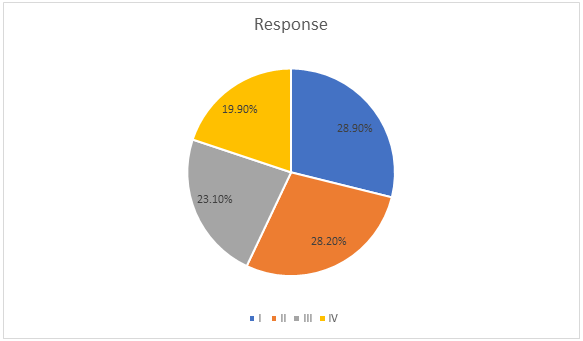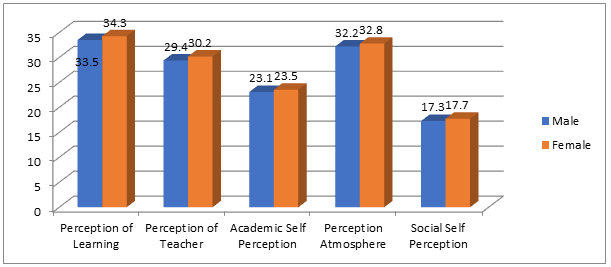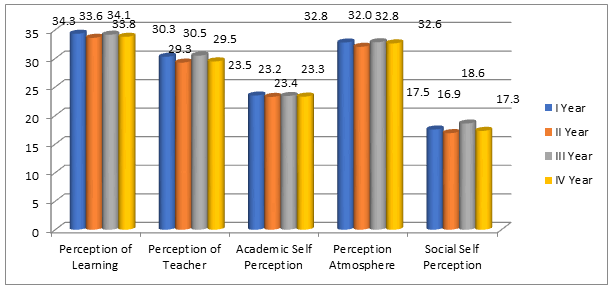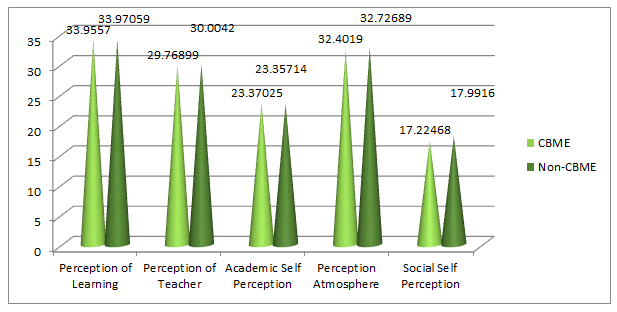Research Article - International Journal of Medical Research & Health Sciences ( 2023) Volume 12, Issue 6
Educational Milieu: An Insight of Medical Students at a Tertiary Care Medical College in Chengalpet Using DREEM Questionnaire
Meena Andiappan*, Ezhil Nila, Priyadarshini Dhavakumar and GayathriMeena Andiappan, Department of Medical Research and Health Sciences, Chengalpattu Medical College, Tamil Nadu, India, Email: ameena005@gmail.com
Received: 24-Mar-2023, Manuscript No. IJMRHS-23-92879; Editor assigned: 29-Mar-2023, Pre QC No. IJMRHS-23-92879(PQ); Reviewed: 12-Apr-2023, QC No. IJMRHS-23-92879; Revised: 09-May-2023, Manuscript No. IJMRHS-23-92879(R); Published: 06-Jun-2023, DOI: -
Abstract
Background: Educational Environment (EE) is defined around the learner which involves a network of interactive forces, conditions and external stimuli that has a direct impact on academic performance and wellbeing of the learner. Implementation of a holistic curriculum and its success depends on the educational environment of an institute. Our study aimed to explore the understanding of medical student’s perception of the EE and to ascertain the areas of strengths and deficiencies as well as to propose curative measures to overcome the paucities.
Methodology: This cross-sectional study was conducted among 554 students across four years of MBBS during the academic year 2021-2022. The DREEM questionnaire was used to measure students’ perceptions about the EE, which has five domains: Students’ perceptions of learning; students’ perceptions of teachers; students’ academic self-perceptions; students’ perceptions of atmosphere and students’ social self-perceptions. Students were asked to respond using a 5-point Likert-type scale. Data was analysed using suitable tests and statistical significance was set at p<0.05.
Results: The mean DREEM score was 137.28 ± 25.07 out of a maximum score of 200. The scores of the subscale were as follows: Student’s perception of learning 33.96 ± 5.48, student’s perception of teachers 29.87 ± 4.84, academic self-perception 23.36 ± 4.43, perception of atmosphere 32.54 ± 6.89 and social self-perception 17.55 ± 3.47. There were no significant differences in perception of educational environment among gender and across various years of MBBS.
Conclusion: The study denotes that there is a good standard upheld by the institute but there is a definite prospect of enhancement. Strengths and imperfections identified through the analysis will facilitate the course organizers to procure definitive steps towards excellence.
Keywords
Educational milieu, Tertiary care, DREEM questionnaire, Educational environment
Introduction
Educational Environment (EE), in any educational institute across the globe, is thought as the design, manner and the way curriculum is imparted. It is defined as a dynamic, complex structure with multiple interrelated and interactive facets that involve the trainee, the trainees interaction with their peers, supervisors and other members of the team, the training program and the structure of the organization that one works in’ [1]. Though the medical education curriculum has been adjusted to the new paradigm shifts concerning teaching learning methodology and competence assessment, the elements of EE unique to each individual determines the learning outcome. Recently medical education in India delivered by private medical colleges is concerned and centered on the EE as the academic excellence of any medical institute is dependent on the learning environment. Learning environment not only influences the academic performance of a student but also contributes to their satisfaction, critical thinking, self-confidence, aspirations and other personal traits. Further, the guidelines of World federation of medical education states one of the objectives of evaluating the medical education program is to assess the learning environment. In the modern era of accreditation and quality assurance, curricular reformation has to be done by identifying and improving the grey areas [2]. The quality of the curriculum is reflected by the quality of the educational environment and a conducive learning environment is essential for positive learning outcome. Though the medical curriculum and its delivery is monitored periodically by the regulatory body of medical education, the “educational environment” which is vital to the success of medical education is not evaluated on a regular basis. The novelties in medical education and diversity in student population have paved the way for a desire and the need to assess the EE of medical colleges. There are numerous tools available to gauge the student’s perception of learning environment. Some of the assessment tools described in various publications include Accreditation Council for Graduate Medical Education (ACGME), Learning Environment Assessment (LEA), Medical School Environment Questionnaire (MSEQ), Course Valuing Inventory (CVI) and many more. Then again, none of them have strong evidence supporting their validity. The Dundee Ready Education Environment Measure (DREEM) questionnaire is the most widely used diagnostic tool to evaluate the perception of EE by medical and other health care students. It is also used as a measure to diagnose the deficiencies in the current EE. The questionnaire is culturally indeterminate and allows comparison between courses as well as within components of a course [3].
Many research studies have been done on EE by numerous medical colleges across the globe. But with the transformation of traditional medical curriculum to Competency Based Medical Education (CBME) in India, further exploration is required in Indian scenario. Hence our study is aimed:
• To explore the insight of undergraduate medical students about their EE.
• To ascertain both strengths and flaws in the student’s EE.
• To compare the perception of EE across various phases of MBBS and also between CBME and non-CBME batches.
• To propose curative measures to overcome the paucities [4].
Materials and Methods
A cross-sectional prospective study was conducted at Chettinad academy of research and education, between September-December 2021. The DREEM questionnaire was used to ascertain the perception of MBBS students concerning their educational environment [5].
The DREEM questionnaire was developed to measure the educational environment of health professional programs. The questionnaire is described to be pertinent for use across various health professional programs and not just medicine. It is also said to be neither culture nor context specific. The DREEM questionnaire has 50 items which are divided into five subscales:
• Student’s perception of learning-12 items
• Student’s perception of teachers-11 items
• Student’s academic self-perception-8 items
• Student’s perception of atmosphere-12 items
• Student’s social self-perception-7 items
Each item is evaluated using a 5-point Likert scale and respondents have to choose a response for each statement [6]. The questionnaire also has negative statements which needs recoding prior to the calculation of total score. The interpretation of DREEM score has been attached in the annexure [7].
This study was undertaken among MBBS students across various phases of Chettinad hospital and research institute which had students of both CBME (Competency Based Medical Education) and non CBME curriculum [8]. The institutional ethical committee approval was obtained to conduct the study and our study adhered to the principles of declaration of Helsinki. All students enrolled in MBBS were eligible to participate in the study and an e mail was sent including the informed consent form and DREEM questionnaire to all the MBBS students in different phases of their curriculum. Students were briefed about the objectives of the study and the significance of their high level of participation in the study. Students were also informed that all responses would be confidential and unrevealed. The students were instructed to read the questions conscientiously and opt an answer of their choice [9].
Data collected were entered in MS excel and then subject to statistical analysis in SPSS version 21. Each item in DREEM questionnaire was analyzed for mean, standard deviation and standard error of the mean [10]. Apart from this, Cronbach’s alpha coefficient to assess the internal consistency of DREEM questionnaire, item total correlation and one-way Anova for comparison of mean domain scores and DREEM score across gender and between years of study among medical students were done. p value of <0.05 is considered to be significant [11].
Results
A total of 800 students were in various phases of MBBS (250 students each in I and II MBBS, 150 students each in III and IV MBBS), of which 589 students participated in the study. Five hundred and fifty-four responses were received from 589 participants representing a response rate of 94%. The response rate by year level is represented in Figure 1. Of the total 554 participants, 40.6% were male and 59.4% were female [12].
The mean DREEM total score was 137.29 ± 25.11 with the standard error mean equal to 1.83 (CI-133.70-140.89). Total DREEM scores ranged from 81 to 183. The descriptive statistics for each of the DREEM items are presented in Table 1 and those for DREEM subscales are given in (Table 2 and Figures 2-4) [13].
| Variable | Mean | Std. Dev. | Std. Err. | 95% Conf. interval | Item test correlation | |
|---|---|---|---|---|---|---|
| Lower | Upper | |||||
| q1 | 3.10108 | 0.85297 | 0.03624 | 3.0299 | 3.17227 | 0.6879 |
| q2 | 3.12635 | 0.98189 | 0.04172 | 3.04441 | 3.2083 | 0.4509 |
| q3 | 2.58845 | 1.04351 | 0.04433 | 2.50136 | 2.67553 | 0.3334 |
| q4 | 1.3574 | 1.04443 | 0.04437 | 1.27024 | 1.44456 | 0.1852 |
| q5 | 2.69856 | 0.99061 | 0.04209 | 2.61589 | 2.78123 | 0.5893 |
| q6 | 3.23827 | 0.82955 | 0.03524 | 3.16904 | 3.3075 | 0.5583 |
| q7 | 2.87184 | 0.86305 | 0.03667 | 2.79982 | 2.94387 | 0.6653 |
| q8 | 2.2509 | 1.12679 | 0.04787 | 2.15687 | 2.34494 | 0.048 |
| q9 | 1.50903 | 1.07617 | 0.04572 | 1.41922 | 1.59884 | 0.1744 |
| q10 | 3.14982 | 0.73478 | 0.03122 | 3.0885 | 3.21114 | 0.5486 |
| q11 | 2.84116 | 0.84838 | 0.03604 | 2.77036 | 2.91196 | 0.6877 |
| q12 | 3.22563 | 0.70493 | 0.02995 | 3.1668 | 3.28446 | 0.7454 |
| q13 | 2.95848 | 0.83984 | 0.03568 | 2.8884 | 3.02857 | 0.6662 |
| q14 | 2.37726 | 1.07087 | 0.0455 | 2.28789 | 2.46662 | 0.3649 |
| q15 | 3.20036 | 0.78037 | 0.03316 | 3.13524 | 3.26549 | 0.3547 |
| q16 | 3.20217 | 0.61235 | 0.02602 | 3.15106 | 3.25327 | 0.6516 |
| q17 | 1.77617 | 1.15071 | 0.04889 | 1.68014 | 1.8722 | 0.1031 |
| q18 | 3.16607 | 0.81877 | 0.03479 | 3.09774 | 3.23439 | 0.7923 |
| q19 | 2.86282 | 0.88137 | 0.03745 | 2.78926 | 2.93637 | 0.626 |
| q20 | 3.24188 | 0.59775 | 0.0254 | 3.19199 | 3.29176 | 0.7035 |
| q21 | 3.04513 | 0.74128 | 0.03149 | 2.98326 | 3.10699 | 0.7285 |
| q22 | 3.05957 | 0.66837 | 0.0284 | 3.00379 | 3.11535 | 0.767 |
| q23 | 2.88267 | 0.86039 | 0.03656 | 2.81087 | 2.95447 | 0.6748 |
| q24 | 3.11191 | 0.72549 | 0.03082 | 3.05137 | 3.17246 | 0.7323 |
| q25 | 1.08664 | 0.65857 | 0.02798 | 1.03168 | 1.1416 | 0.388 |
| q26 | 2.8213 | 0.70814 | 0.03009 | 2.7622 | 2.8804 | 0.5951 |
| q27 | 2.29061 | 0.9902 | 0.04207 | 2.20798 | 2.37325 | 0.6279 |
| q28 | 2.1444 | 1.04894 | 0.04457 | 2.05687 | 2.23194 | 0.3853 |
| q29 | 3.11191 | 0.6464 | 0.02746 | 3.05797 | 3.16586 | 0.6331 |
| q30 | 2.84296 | 0.94834 | 0.04029 | 2.76382 | 2.9221 | 0.6874 |
| q31 | 3.09747 | 0.73745 | 0.03133 | 3.03593 | 3.15902 | 0.6127 |
| q32 | 2.58484 | 0.88846 | 0.03775 | 2.51069 | 2.65898 | 0.2579 |
| q33 | 3.07762 | 0.68787 | 0.02923 | 3.02021 | 3.13502 | 0.6618 |
| q34 | 2.59747 | 1.08186 | 0.04596 | 2.50719 | 2.68776 | 0.6854 |
| q35 | 2.6426 | 0.92897 | 0.03947 | 2.56507 | 2.72013 | 0.2719 |
| q36 | 2.72202 | 0.84963 | 0.0361 | 2.65112 | 2.79293 | 0.5783 |
| q37 | 3.213 | 0.65723 | 0.02792 | 3.15815 | 3.26784 | 0.7113 |
| q38 | 3.21119 | 0.65918 | 0.02801 | 3.15618 | 3.2662 | 0.7013 |
| q39 | 2.33755 | 1.07063 | 0.04549 | 2.2482 | 2.42689 | 0.3821 |
| q40 | 3.38267 | 0.61752 | 0.02624 | 3.33114 | 3.43421 | 0.5454 |
| q41 | 2.98195 | 0.82876 | 0.03521 | 2.91279 | 3.05111 | 0.705 |
| q42 | 2.27076 | 1.14373 | 0.04859 | 2.17531 | 2.36621 | 0.5969 |
| q43 | 2.8574 | 0.94298 | 0.04006 | 2.77871 | 2.9361 | 0.7958 |
| q44 | 3.05596 | 0.80826 | 0.03434 | 2.98851 | 3.12341 | 0.7931 |
| q45 | 3.27978 | 0.69307 | 0.02945 | 3.22194 | 3.33762 | 0.6656 |
| q46 | 3.02347 | 0.80088 | 0.03403 | 2.95663 | 3.0903 | 0.6878 |
| q47 | 2.92419 | 0.77345 | 0.03286 | 2.85964 | 2.98874 | 0.545 |
| q48 | 2.13718 | 0.95805 | 0.0407 | 2.05723 | 2.21714 | 0.244 |
| q49 | 2.80505 | 1.09325 | 0.04645 | 2.71382 | 2.89629 | 0.5709 |
| q50 | 1.94946 | 1.03167 | 0.04383 | 1.86336 | 2.03556 | 0.3632 |
Table 1. Descriptive statistics and item total correlation.
| Sub scales | Mean | Std. Dev. | Sub scale score interpretation | Alpha |
|---|---|---|---|---|
| Perception of learning | 33.96209 | 5.47792 | A more positive approach | 0.874a |
| Perception of teacher | 29.87004 | 4.83856 | Moving in the right direction | 0.662b |
| Academic self-perception | 23.36462 | 4.42914 | Feeling more on the positive side | 0.836 |
| Perception atmosphere | 32.54152 | 6.89492 | A more positive atmosphere | 0.843c |
| Social self perception | 17.55415 | 3.46694 | Not too bad | 0.554d |
Note: aImproves to 0.891 if question 48 is removed; bImproves to 0.699 if question 8 is removed and to 0.7129 if question 9 is removed; cImproves to 0.849 if question 35 is removed and to 0.871 if question 17 is removed; dImproves to 0.618 if question 4 is removed
Table 2 Descriptive statistics for DREEM subscales.
Discussion
The interpretation of DREEM score can be done at three levels: 1) Overall 2) Subscale and 3) Items. The mean DREEM score as perceived by the students was 137 implying a more positive than negative environment according to the interpretation proposed. This overall score is significantly higher compared to other studies conducted in various Indian medical universities like 119 (Mumbai), 122.4 (Karnataka), 118.39 and 112.46 (first year and second year medical students of Rajasthan) [14].
The mean score of DREEM subscales also revealed an optimistic and positive intuition on the institute by the students. The subscale scores of Perceptions of learning, academic self-perception and perception of atmosphere were in the category of “more positive approach”, while perception of teachers is grouped as “moving in the right direction” and social self-perception falls under “not too bad” category. These results were consistent with a study done by among final year medical students in Mumbai.
With respect to the scores of each item in DREEM score, the gray areas include teachers over emphasizing on factual learning, too tired to enjoy the course, teachers are authoritative and cheating. All these items had a score of less than 2. These results are distinct from a study conducted where “students irritate the teachers” and “teachers ridicule the students” had a score of less than 2. Educational environment is not just the infrastructure but also the faculty who are conducive in learning. An idealistic teaching learning can be established by improving the student teacher interactions. Some of the measures like effective communication, active engagement, constructive feedback and interactive learning strategies may help in strengthening the teacher student relationship. Besides, employing novel interactive strategies to promote critical thinking is more likely to result in competent and dignified doctors apart from reducing boredom among students (optometry).
The strength of the educational environment as indicated by the maximum score is ‘faculties are well prepared for teaching sessions”. In a study conducted among students of optometry, “the teachers are knowledgeable” had the highest score. These findings suggest the overall positive perception of teachers by the students. There was no significant difference in perception of educational environment between genders though the mean score is greater among female students (138.5) than male students (135.5). This is comparable to the finding noted by where female students had better perception of educational environment than male students. However, another study recognized a significantly lesser DREEM score among female students compared to male students.
Conclusion
The mean DREEM scores in each subscale among various phases of MBBS showed a similar result with minor differences across the groups which is not statistically significant. Also, the subscale score among CBME and non- CBME groups though had no statistically significant difference; students of non-CBME batch had better perception of educational environment compared with CBME batch students. This could be attributed to the COVID 19 pandemic situation which led to implementation of online teaching strategies replacing the traditional didactic lectures. Though online classes had its own advantage during the pandemic, certain factors like lack of motivation and learning style had a definite impact on the mental state of students.
Our study reported a more positive educational environment with certain areas that require amendments to promote better outlook of the institute in the future. Moreover, the study results can be used as an evaluation strategy to assess the changes and also to provide information for accreditation of the institute.
References
- Fed R. Change in terminology: "Mental retardation" to "intellectual disability." Final rule. Federal Register, Vol. 78, No. 148, 2013, pp. 499-502.
[Google Scholar] [PubMed]
- Gibert K, et al. Integrating clinicians, knowledge and data: Expert-based cooperative analysis in healthcare decision support. Health Research Policy and Systems, Vol. 8, No. 1, 2010, pp. 28.
[Crossref] [Google Scholar] [PubMed]
- Carulla LS, et al. Intellectual developmental disorders: Towards a new name, definition and framework for “mental retardation/intellectual disability” in ICD‐11. World Psychiatry, Vol. 10, No. 3, 2011, pp. 175-180.
[Crossref] [Google Scholar] [PubMed]
- Girimaji SC and Srinath S. Perspectives of intellectual disability in India: Epidemiology, policy, services for children and adults. Current Opinion in Psychiatry, Vol. 23, No. 5, 2010, pp. 441-446.
[Crossref] [Google Scholar] [PubMed]
- Jeevanandam L. Perspectives of intellectual disability in Asia: Epidemiology, policy, and services for children and adults. Current Opinion in Psychiatr, Vol. 22, No. 5, 2009, pp. 462-897.
[Crossref] [Google Scholar] [PubMed]
- Harris JC. Intellectual disability: Understanding its development, causes, classification, evaluation, and treatment. Oxford University Press, 2006.
- Shogren KA and Turnbull HR. Public policy and outcomes for persons with intellectual disability: Extending and expanding the public policy framework of AAIDD's 11th edition of intellectual disability: Definition, classification, and systems of support. Intellectual and Developmental Disabilities, Vol. 48, No. 5, 2010, pp. 375-386.
[Crossref] [Google Scholar] [PubMed]
- Kishore MT, et al. Clinical practice guidelines for assessment and management of intellectual disability. Indian Journal of Psychiatry, Vol. 61, No. 2, 2019, pp. 194.
[Crossref] [Google Scholar] [PubMed]
- May ME and Kennedy CH. Health and problem behavior among people with intellectual disabilities. Behavior Analysis in Practice, Vol. 3, No. 2, 2010, pp. 4-12.
[Crossref] [Google Scholar] [PubMed]
- Mulas F and Rojas M. Intellectual developmental disability overlapping with autism spectrum disorder and attention deficit-hyperactivity disorder. Medicina, Vol. 78, No. 2, 2018, pp. 63-68.
[Google Scholar] [PubMed]
- Hidding E, et al. Intellectual functioning in relation to autism and ADHD symptomatology in children and adolescents with 22q11. 2 deletion syndrome. Journal of Intellectual Disability Research, Vol. 59, No. 9, 2015, pp. 803-815.
[Crossref] [Google Scholar] [PubMed]
- Ageranioti-Belanger S, et al. Behaviour disorders in children with an intellectual disability. Paediatrics Child Health, Vol. 17, No.2, 2012, pp. 84-88.
- Rao BSR. Consanguinity and familial mental retardation. Journal of Medical Genetics, Vol. 13, No. 1, 1976, pp. 27-29.
[Crossref] [Google Scholar] [PubMed]
- Hosseinpour M, et al. The effect of consanguineous marriage on mental health among the students of the Shahrekord university of medical sciences. Journal of Clinical and Diagnostic Research: JCD, Vol. 10, No. 11, 2016, pp. 01.
[Crossref] [Google Scholar] [PubMed]




